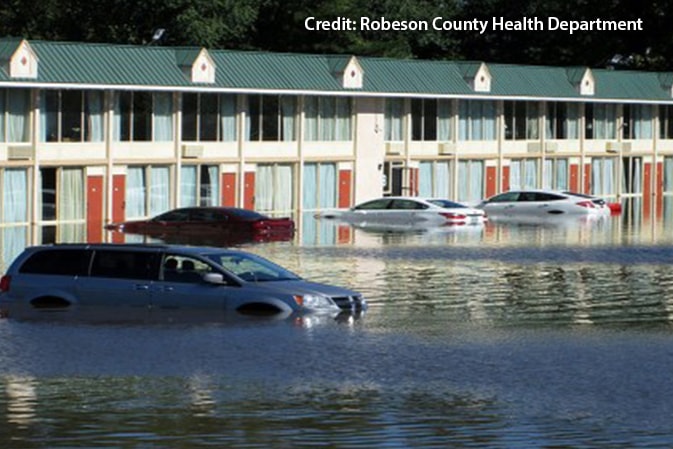Flooding from Hurricane Matthew in North Carolina
CDC’s Public Health Emergency Preparedness (PHEP) cooperative agreement program is a critical source of funding, guidance, and technical assistance for state, local, tribal, and territorial public health departments to strengthen their public health preparedness capabilities. Since 9/11, the PHEP program has saved lives by building and maintaining a nationwide public health emergency management system that enables communities to rapidly respond to public health threats. .
In October 2016, Hurricane Matthew made landfall in southeastern North Carolina, causing catastrophic flooding and killing 28 people. Swollen and cresting rivers inland remained above flood levels for weeks after the storm, wreaking havoc on the poorest counties in the state. The models forecasting the path of the storm were unpredictable and varied, making preparedness difficult. However, North Carolina is seasoned in dealing with coastal storms, and the state health department was able to lean on past experience and a strong relationship with emergency management agencies and surrounding states to integrate public health in emergency response and, in collaboration with partners, lead and coordinate the public health and healthcare sectors.
Matthew did not behave in the way that Atlantic hurricanes typically do. In North Carolina, tropical systems usually make landfall at the southeastern beach areas, and then track upward to the Outer Banks. Matthew came up through South Carolina for a more direct hit on inland southeastern NC – and stalled – before heading back out to sea. The storm’s slow movement across the region caused devastating and unanticipated flooding. But through lessons learned from previous storms and other incidents, the state health department had the systems in place to quickly move resources to the affected areas.
North Carolina public health nurses and environmental health specialists were brought in from unaffected parts of the state to staff shelters, inspect facilities, and conduct well water and septic system testing in flood-affected areas. A recently hired and PHEP-funded fatality manager investigated the 28 storm-related deaths and is studying the 19 deaths that occurred by people drowning in their vehicles, to determine why this occurred in such high numbers. All of the emergency activities were coordinated in the state’s emergency operations center, or EOC, where 16 PHEP-funded staff logged 921 hours. Additionally, due to preexisting relationships with surrounding states, North Carolina was able to request and receive 20 public health nurses from Tennessee within three hours.
Contributing to the devastation wrought by Matthew was the fact that the hardest hit areas were also the poorest counties in the state, with consistently the worst health problems and poorest health infrastructure. Former North Carolina PHEP director Julie Casani, M.D., believes that addressing pervasive issues such as poverty and chronic health is the key to building truly resilient communities.
“The people who are the most vulnerable during an emergency are the people who are vulnerable every day,” Dr. Casani said. “You can’t fix these gaps during a disaster when they have been made so much worse, when you are asking people who already don’t have enough to make do with even less.”

Hurricane Matthew came up through South Carolina for a more direct hit on inland southeastern NC – and stalled – before heading back out to sea. The storm’s slow movement across the region caused devastating and unanticipated flooding.
The Incident
In October 2016, Hurricane Matthew made landfall in southeastern North Carolina as a Category 1 storm, causing catastrophic flooding and killing 28 people.
The Response
North Carolina relied on relationships with partners and past experience to respond to a very unpredictable storm and its impact.
The Outcomes
Within hours, North Carolina was able to request/receive and move resources and personnel to areas of critical need.